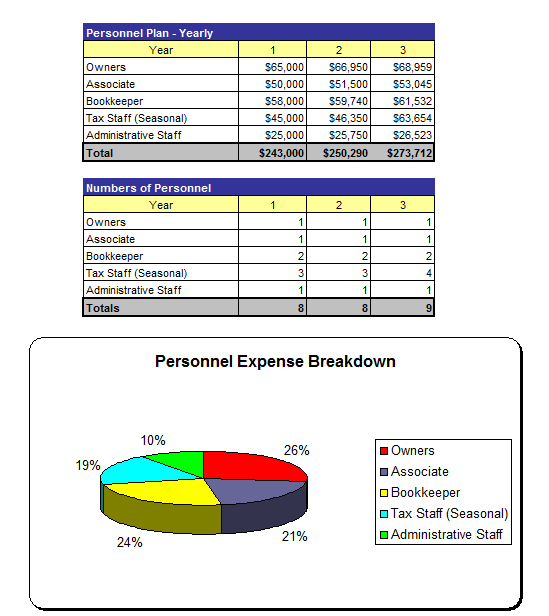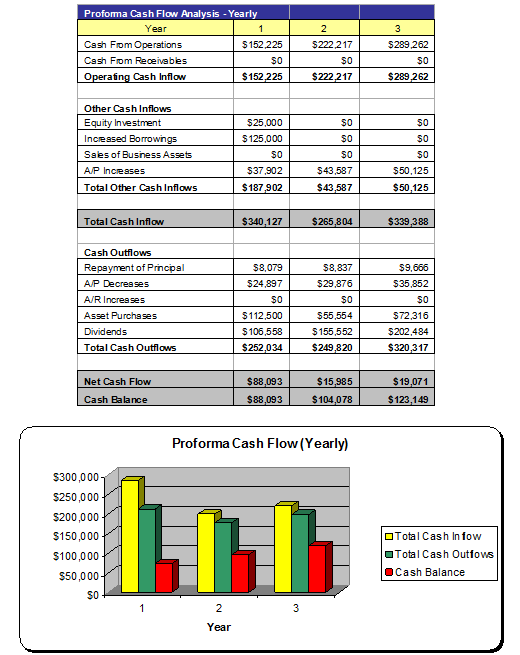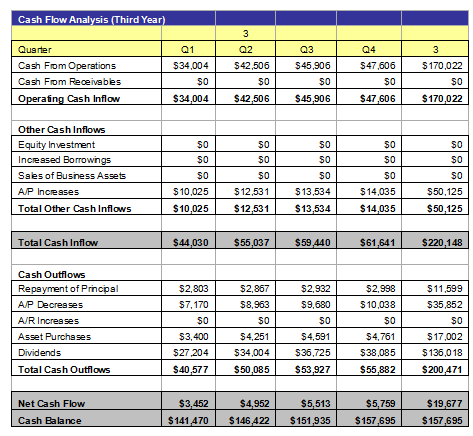Free Software Developer Business Plan
For Raising Capital from Investors, Banks, or Grant Companies!
Please note that the financials
in this complete free business plan are completely fictitious and may not
match the text of the business plan below. This free business plan demonstration
purposes only. If you are interested in purchasing the completed editable MS Word
and Excel documents for this business plan, please click the button below! Also,
the text of the business plan is formatted with a fully automated
table of contents.
Return to
Samples Page
It should be noted that there is no special software required to use these
templates. All business plans come in Microsoft Word and Microsoft Excel format.
Each business plan features:
- Excecutive Summary
- Company and Financing Summary
- Products and Services Overview
- Strategic Analysis with current research!
- Marketing Plan
- Personnel Plan
- 3 Year Advanced Financial Plan
- Expanded Financial Plan with Monthly Financials
- Loan Amortization and ROI Tools
- FREE PowerPoint Presentation for Banks, Investors,
or Grant Companies!
1.0 Executive Summary
The purpose of this business plan is to raise $150,000 for the development of a software development company while showcasing the expected financials and operations over the next three years. The Software Developer, Inc. (“the Company”) is a New York based corporation that will provide custom built software solutions for retailers, medical businesses, financial companies, and other businesses in need of custom software. The Company was founded in 2009 by John Doe.
1.1 Products and Services
As stated above, the business will be actively engaged in the development of custom software solutions for small, medium, and large scale businesses that have unique database or computer interface needs. The Company will generate revenues from the initial development of custom software coupled with recurring streams of revenue from upgrade and maintenance fees. At the onset of operations, the Company intends to have a programming staff of seven people, which will expand to nine people during the first three years of operation. The third section of the business plan will further describe the services offered by the Software Developer.
1.2 The Financing
Mr. Doe is seeking to raise $150,000 from as a bank loan. The interest rate and loan agreement are to be further discussed during negotiation. This business plan assumes that the business will receive a 10 year loan with a 9% fixed interest rate.
1.3 Mission Statement
Management’s mission is to provide his customers with state of the art custom computing solutions to his clients.
1.4 Mangement Team
The Company was founded by John Doe. Mr. Doe has more than 10 years of experience in the technology and computer programming industry. Through his expertise, he will be able to bring the operations of the business to profitability within its first year of operations.
1.5 Sales Forecasts
Mr. Doe expects a strong rate of growth at the start of operations. Below are the expected financials over the next three years.

1.6 Expansion Plan
The Founder expects that the business will aggressively expand during the first three years of operation. Mr. Doe intends to implement marketing campaigns that will effectively target small, medium, and large businesses in the target market.
2.0 Company and Financing Summary
2.1 Registered Name and Corporate Structure
Software Developer, Inc. The Company is registered as a corporation in the State of New York.
2.2 Required Funds
At this time, the Software Developer requires $150,000 of debt funds. Below is a breakdown of how these funds will be used:

2.3 Investor Equity
Mr. Doe is not seeking an investment from a third party at this time.
2.4 Management Equity
John Doe owns 100% of the Software Developer, Inc.
2.5 Exit Strategy
If the business is very successful, Mr. Doe may seek to sell the business to a third party for a significant earnings multiple. Most likely, the Company will hire a qualified business broker to sell the business on behalf of the Software Developer. Based on historical numbers, the business could fetch a sales premium of up to 5 to 8 times earnings based on the recurring revenues of the business.
3.0 Products and Services
Below is a description of the custom software services offered by the Software Developer.
3.1 Initial Development of Software
Mr. Doe and his staff specialize in the development of custom software applications for both online and offline management of business operations. Software modules needed for businesses include accounting software modules, inventory management applications, customer management applications, payroll management modules, and other programs that relate to the day to day operations of a business. The business’ that the Company will target will mostly consist of medium and large scale businesses that have unique computing needs. In the future, the Software Developer may aggressively expand by developing off the shelf business software (or gaming software) that can be sold through traditional retail outlets.
3.2 Upgrade and Maintenance Fees
In addition to the initial fees generated from developing custom software, the business will also recognize recurring revenue streams from maintenance, technical support, and upgrade fees for custom software developed by the Company.
4.0 Strategic and Market Analysis
4.1 Economic Outlook
This section of the analysis will detail the economic climate, the software programming industry, the customer profile, and the competition that the business will face as it progresses through its business operations. Currently, the economic market condition in the United States is in recession. This slowdown in the economy has also greatly impacted real estate sales, which has halted to historical lows. Many economists expect that this recession will continue until mid-2010, at which point the economy will begin a prolonged recovery period. However, the business will generate recurring streams of revenue from ongoing monthly usage, miscellaneous service fees, upgrades, and maintenance fees. Once this revenue base is established, the Company will be immune from deleterious changes in the general economy. By the third year of revenue generation, approximately 50% of the Company’s revenues will come from recurring sources.
4.2 Industry Analysis
The computer software industry is extremely important to both businesses and individual users. The specialized software industry generates in excess of $60 billion dollars a year. The market is comprised of approximately 12,000 establishments that operate throughout the continental United States. Additionally, the industry employs more than 300,000 people and generates gross annual payrolls of $18 billion dollars. The industry has had tremendous growth over the last twenty years. As more businesses and individuals demand more sophisticated data management systems, the industry has seen its growth increase to an average five year compounded growth rate of 70.1%. This trend is expected to continue as the need for Internet, intranet, and wireless communications continues to grow beyond the standard economic rate of growth. Additionally, the technology landscape is an ever-changing arena of business where new technologies and businesses are being developed on a regular basis and with this growth is the need for continually upgrading and improving existing software platforms.
4.3 Customer Profile
The Company’s average client will most likely be a mid-sized or large business that has unique computing needs and requires custom interfaces and databases for the management of their business processes. As the Software Develop can develop technology for any business, clients will come from many different industries.
4.4 Competitive Analysis
This is one of the sections of the business plan that you must write completely on your own. The key to writing a strong competitive analysis is that you do your research on the local competition. Find out who your competitors are by searching online directories and searching in your local Yellow Pages. If there are a number of competitors in the same industry (meaning that it is not feasible to describe each one) then showcase the number of businesses that compete with you, and why your business will provide customers with service/products that are of better quality or less expensive than your competition.
5.0 Marketing Plan
The Software Developer intends to maintain an extensive marketing campaign that will ensure maximum visibility for the business in its targeted market of medium and large businesses. Below is an overview of the marketing strategies and objectives of the Software Developer.
5.1 Marketing Objectives
-
• Develop an online presence by developing a website and placing the Company’s name and contact information with online directories.
-
• Implement a regional campaign with the Company’s targeted market via the use of newspaper advertisements and word of mouth from existing clients.
-
• Establish relationships with other software developers so that the business can act in a subcontracting capacity.
5.2 Marketing Strategies
Mr. Doe intends on using a number of marketing strategies that will allow the Software Developer to target medium and large organizations that have unique computing needs. These strategies include traditional print advertisements and ads placed on search engines on the Internet. The business will also attend many industry functions and conventions with booths that showcase the Software Developer’s ability to produce completely custom software solutions for business clients. The Software Developer will also use an internet based strategy. This is very important as many people seeking specialized programming services now the Internet to conduct their preliminary searches. Mr. Doe will register the Software Developer’s website with online portals so that potential clients can easily reach the business. The Company’s website will showcase the experience of the Company’s programmers, the services its offers, preliminary pricing, and relevant contact information. Mr. Doe will also work with other software development companies so that the business can generate additional business acting as a subcontractor for other companies that develop business platforms for customers.
5.3 Pricing
In this section, describe the pricing of your services and products. You should provide as much information as possible about your pricing as possible in this section. However, if you have hundreds of items, condense your product list categorically. This section of the business plan should not span more than 1 page.
6.0 Organizational Plan and Personnel Summary
6.1 Corporate Organization

6.2 Organizational Budget

6.3 Management Biographies
In this section of the business plan, you should write a two to four paragraph biography
about your work experience, your education, and your skill set. For each owner or
key employee, you should provide a brief biography in this section.
7.0 Financial Plan
7.1 Underlying Assumptions
-
• The Software Developer will have an annual revenue growth rate of 16% per year.
-
• The Owner will acquire $150,000 of debt funds to develop the business.
-
• The loan will have a 10 year term with a 9% interest rate.
7.2 Sensitivity Analysis
In the event of an economic downturn, the business may have a decline in its revenues. Specialized software modules for businesses are expensive, and during deleterious economic conditions the Company may have issues with top line revenues. However, once the Company is established, the Company will generate recurring streams of revenue on a monthly basis, which will ensure the continued profitability of the Software Developer.
7.3 Source of Funds

7.4 General Assumptions

7.5 Profit and Loss Statements

7.6 Cash Flow Analysis

7.7 Balance Sheet
 .
.
7.8 General Assumptions

7.9 Business Ratios

Expanded Profit and Loss Statements




Expanded Cash Flow Analysis



